Financial Analysis of Tesco and Sainsbury: A Comparative Report
VerifiedAdded on 2023/01/05
|17
|3747
|62
Report
AI Summary
This report provides a detailed financial analysis of Tesco and Sainsbury PLC, two major players in the retail industry. The analysis is divided into two portfolios. Portfolio 1 focuses on calculating and interpreting various financial ratios, including current ratio, quick ratio, net profit margin, gross profit margin, gearing ratio, price earnings ratio, earnings per share, return on capital employed, average inventories turnover ratio, and dividend payout ratio, for both companies over the years 2018 and 2019. The report compares their financial positions, performance, and investment potential, providing charts to illustrate the trends and offering recommendations for the underperforming company. Portfolio 2 delves into the application of investment appraisal techniques to advise senior management on investment decisions, along with a discussion of the limitations of these techniques in long-term decision-making. The report concludes with a summary of the key findings and insights derived from the financial analysis.
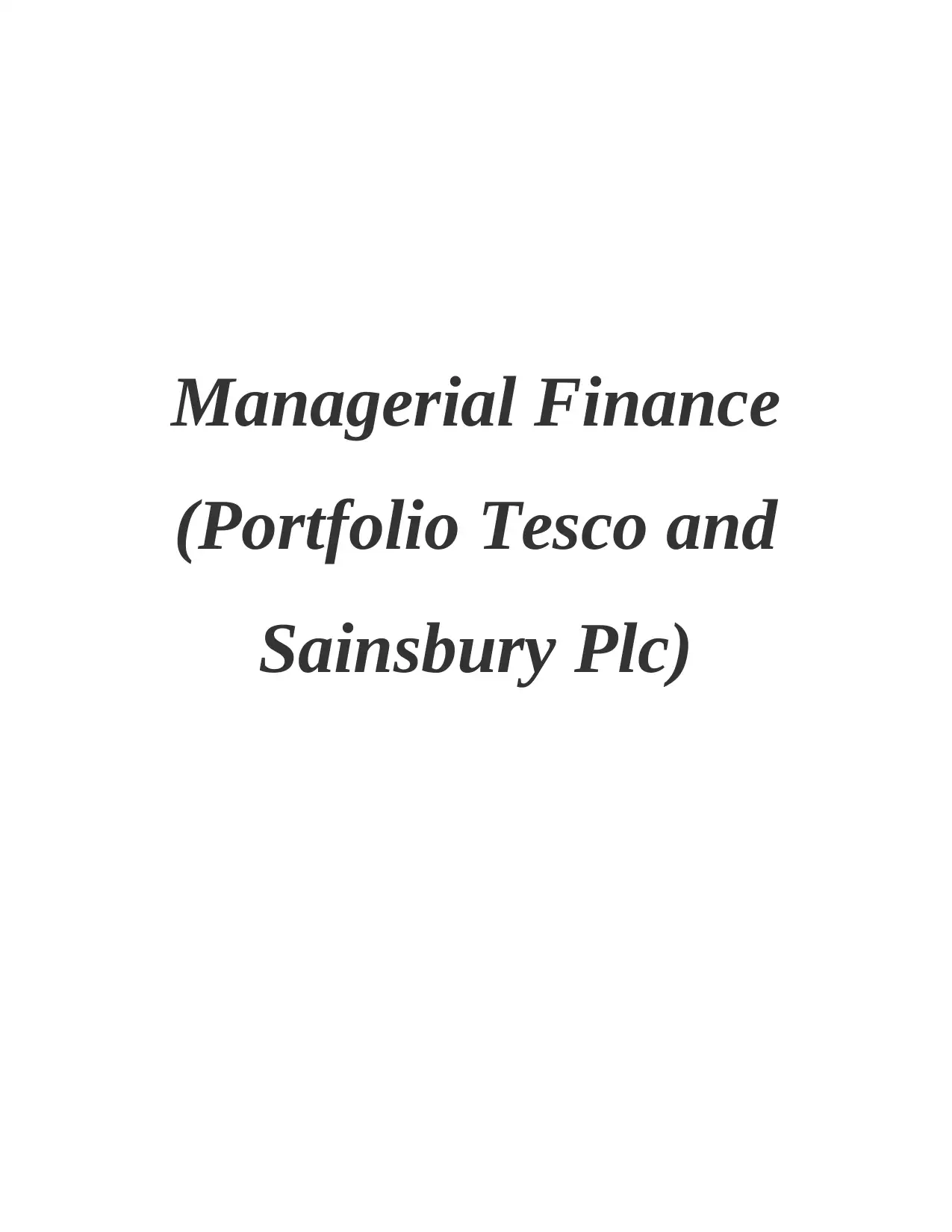
Managerial Finance
(Portfolio Tesco and
Sainsbury Plc)
(Portfolio Tesco and
Sainsbury Plc)
Paraphrase This Document
Need a fresh take? Get an instant paraphrase of this document with our AI Paraphraser
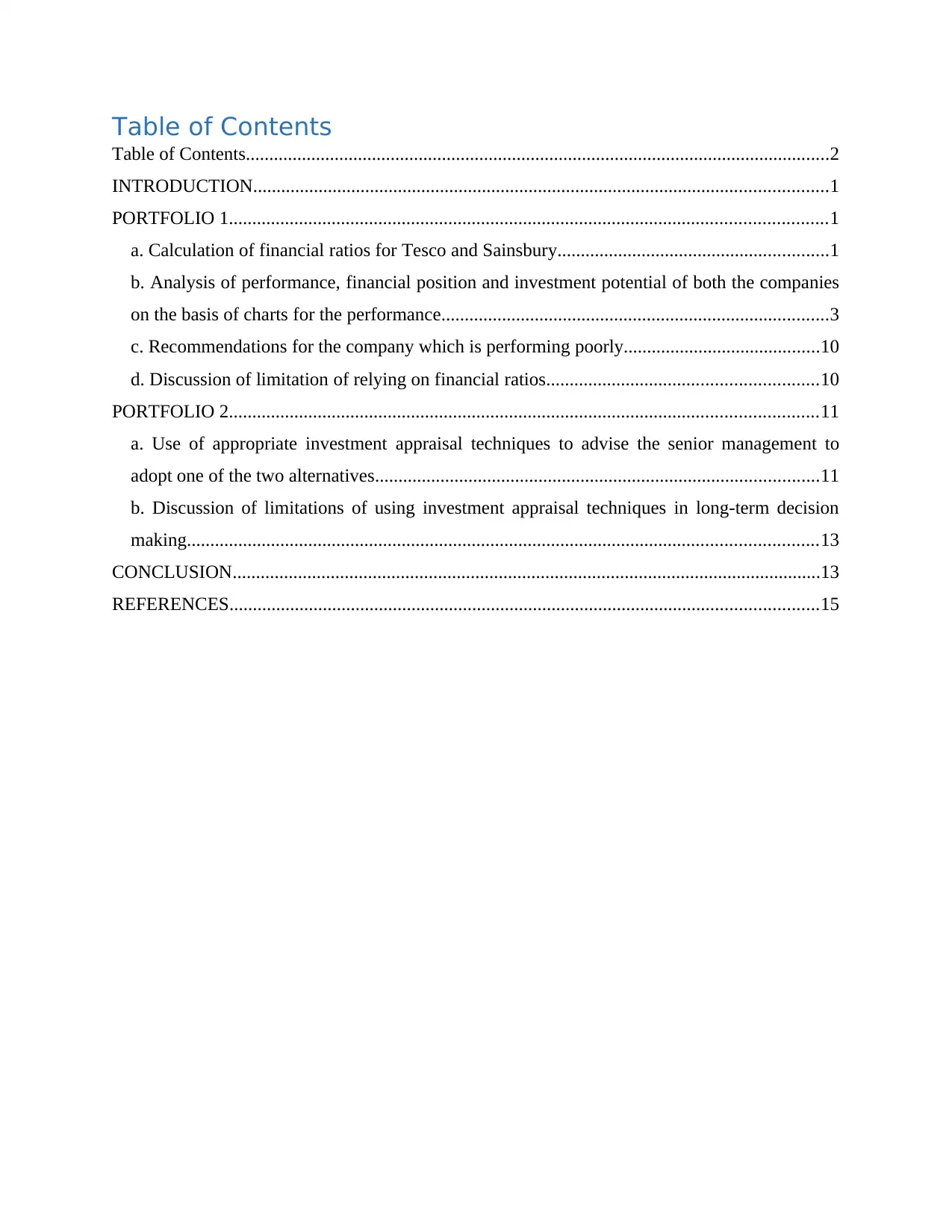
Table of Contents
Table of Contents.............................................................................................................................2
INTRODUCTION...........................................................................................................................1
PORTFOLIO 1................................................................................................................................1
a. Calculation of financial ratios for Tesco and Sainsbury..........................................................1
b. Analysis of performance, financial position and investment potential of both the companies
on the basis of charts for the performance...................................................................................3
c. Recommendations for the company which is performing poorly..........................................10
d. Discussion of limitation of relying on financial ratios..........................................................10
PORTFOLIO 2..............................................................................................................................11
a. Use of appropriate investment appraisal techniques to advise the senior management to
adopt one of the two alternatives...............................................................................................11
b. Discussion of limitations of using investment appraisal techniques in long-term decision
making.......................................................................................................................................13
CONCLUSION..............................................................................................................................13
REFERENCES..............................................................................................................................15
Table of Contents.............................................................................................................................2
INTRODUCTION...........................................................................................................................1
PORTFOLIO 1................................................................................................................................1
a. Calculation of financial ratios for Tesco and Sainsbury..........................................................1
b. Analysis of performance, financial position and investment potential of both the companies
on the basis of charts for the performance...................................................................................3
c. Recommendations for the company which is performing poorly..........................................10
d. Discussion of limitation of relying on financial ratios..........................................................10
PORTFOLIO 2..............................................................................................................................11
a. Use of appropriate investment appraisal techniques to advise the senior management to
adopt one of the two alternatives...............................................................................................11
b. Discussion of limitations of using investment appraisal techniques in long-term decision
making.......................................................................................................................................13
CONCLUSION..............................................................................................................................13
REFERENCES..............................................................................................................................15
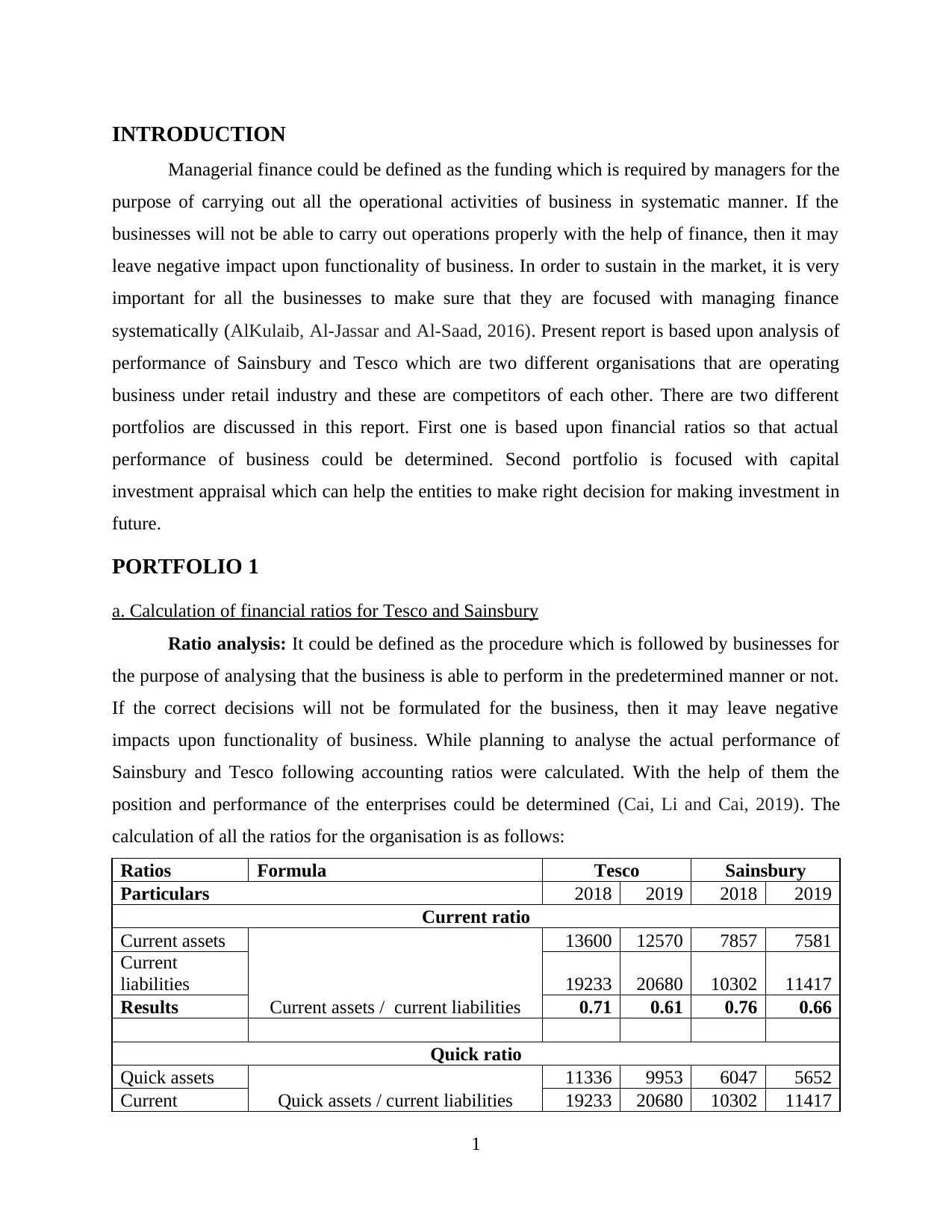
INTRODUCTION
Managerial finance could be defined as the funding which is required by managers for the
purpose of carrying out all the operational activities of business in systematic manner. If the
businesses will not be able to carry out operations properly with the help of finance, then it may
leave negative impact upon functionality of business. In order to sustain in the market, it is very
important for all the businesses to make sure that they are focused with managing finance
systematically (AlKulaib, Al-Jassar and Al-Saad, 2016). Present report is based upon analysis of
performance of Sainsbury and Tesco which are two different organisations that are operating
business under retail industry and these are competitors of each other. There are two different
portfolios are discussed in this report. First one is based upon financial ratios so that actual
performance of business could be determined. Second portfolio is focused with capital
investment appraisal which can help the entities to make right decision for making investment in
future.
PORTFOLIO 1
a. Calculation of financial ratios for Tesco and Sainsbury
Ratio analysis: It could be defined as the procedure which is followed by businesses for
the purpose of analysing that the business is able to perform in the predetermined manner or not.
If the correct decisions will not be formulated for the business, then it may leave negative
impacts upon functionality of business. While planning to analyse the actual performance of
Sainsbury and Tesco following accounting ratios were calculated. With the help of them the
position and performance of the enterprises could be determined (Cai, Li and Cai, 2019). The
calculation of all the ratios for the organisation is as follows:
Ratios Formula Tesco Sainsbury
Particulars 2018 2019 2018 2019
Current ratio
Current assets
Current assets / current liabilities
13600 12570 7857 7581
Current
liabilities 19233 20680 10302 11417
Results 0.71 0.61 0.76 0.66
Quick ratio
Quick assets
Quick assets / current liabilities
11336 9953 6047 5652
Current 19233 20680 10302 11417
1
Managerial finance could be defined as the funding which is required by managers for the
purpose of carrying out all the operational activities of business in systematic manner. If the
businesses will not be able to carry out operations properly with the help of finance, then it may
leave negative impact upon functionality of business. In order to sustain in the market, it is very
important for all the businesses to make sure that they are focused with managing finance
systematically (AlKulaib, Al-Jassar and Al-Saad, 2016). Present report is based upon analysis of
performance of Sainsbury and Tesco which are two different organisations that are operating
business under retail industry and these are competitors of each other. There are two different
portfolios are discussed in this report. First one is based upon financial ratios so that actual
performance of business could be determined. Second portfolio is focused with capital
investment appraisal which can help the entities to make right decision for making investment in
future.
PORTFOLIO 1
a. Calculation of financial ratios for Tesco and Sainsbury
Ratio analysis: It could be defined as the procedure which is followed by businesses for
the purpose of analysing that the business is able to perform in the predetermined manner or not.
If the correct decisions will not be formulated for the business, then it may leave negative
impacts upon functionality of business. While planning to analyse the actual performance of
Sainsbury and Tesco following accounting ratios were calculated. With the help of them the
position and performance of the enterprises could be determined (Cai, Li and Cai, 2019). The
calculation of all the ratios for the organisation is as follows:
Ratios Formula Tesco Sainsbury
Particulars 2018 2019 2018 2019
Current ratio
Current assets
Current assets / current liabilities
13600 12570 7857 7581
Current
liabilities 19233 20680 10302 11417
Results 0.71 0.61 0.76 0.66
Quick ratio
Quick assets
Quick assets / current liabilities
11336 9953 6047 5652
Current 19233 20680 10302 11417
1
⊘ This is a preview!⊘
Do you want full access?
Subscribe today to unlock all pages.

Trusted by 1+ million students worldwide
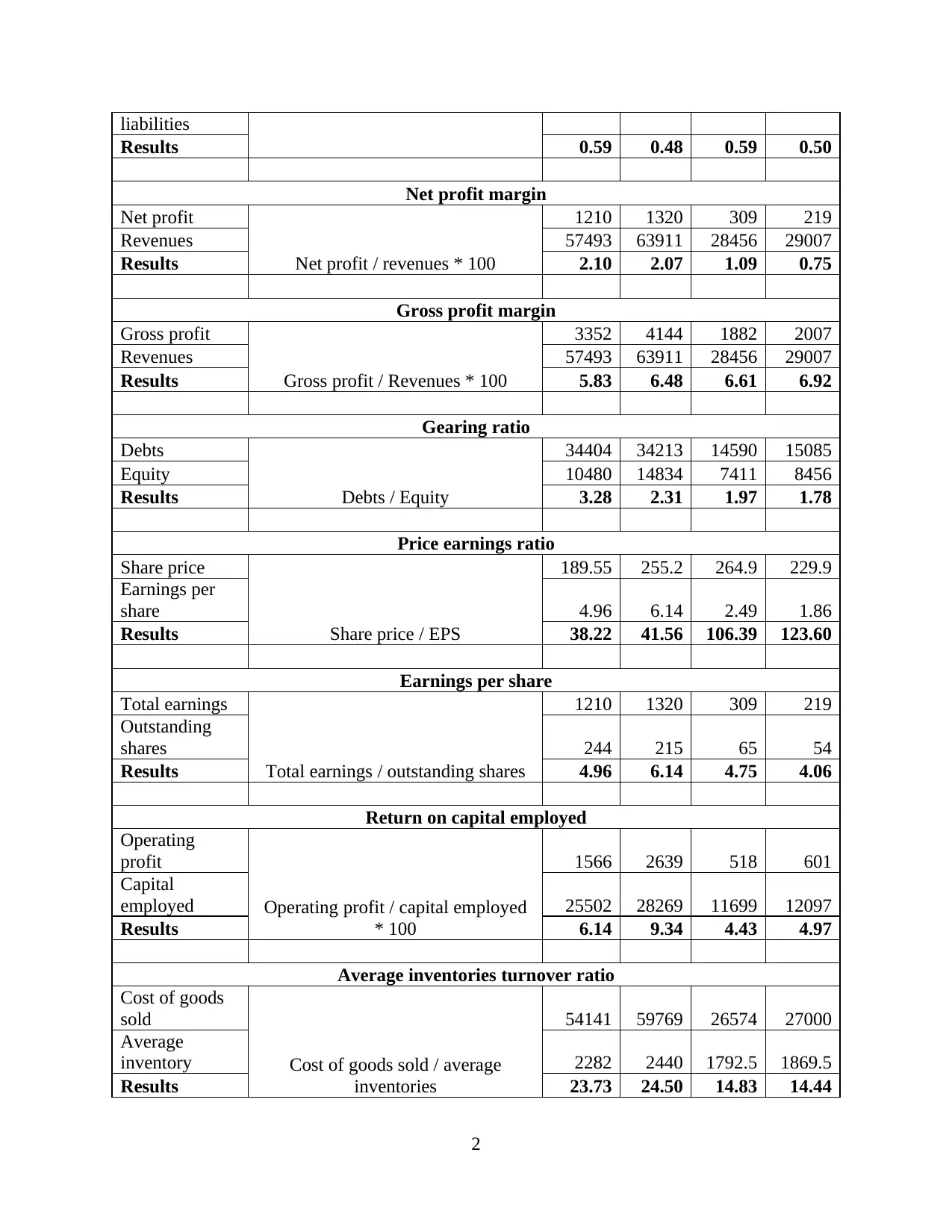
liabilities
Results 0.59 0.48 0.59 0.50
Net profit margin
Net profit
Net profit / revenues * 100
1210 1320 309 219
Revenues 57493 63911 28456 29007
Results 2.10 2.07 1.09 0.75
Gross profit margin
Gross profit
Gross profit / Revenues * 100
3352 4144 1882 2007
Revenues 57493 63911 28456 29007
Results 5.83 6.48 6.61 6.92
Gearing ratio
Debts
Debts / Equity
34404 34213 14590 15085
Equity 10480 14834 7411 8456
Results 3.28 2.31 1.97 1.78
Price earnings ratio
Share price
Share price / EPS
189.55 255.2 264.9 229.9
Earnings per
share 4.96 6.14 2.49 1.86
Results 38.22 41.56 106.39 123.60
Earnings per share
Total earnings
Total earnings / outstanding shares
1210 1320 309 219
Outstanding
shares 244 215 65 54
Results 4.96 6.14 4.75 4.06
Return on capital employed
Operating
profit
Operating profit / capital employed
* 100
1566 2639 518 601
Capital
employed 25502 28269 11699 12097
Results 6.14 9.34 4.43 4.97
Average inventories turnover ratio
Cost of goods
sold
Cost of goods sold / average
inventories
54141 59769 26574 27000
Average
inventory 2282 2440 1792.5 1869.5
Results 23.73 24.50 14.83 14.44
2
Results 0.59 0.48 0.59 0.50
Net profit margin
Net profit
Net profit / revenues * 100
1210 1320 309 219
Revenues 57493 63911 28456 29007
Results 2.10 2.07 1.09 0.75
Gross profit margin
Gross profit
Gross profit / Revenues * 100
3352 4144 1882 2007
Revenues 57493 63911 28456 29007
Results 5.83 6.48 6.61 6.92
Gearing ratio
Debts
Debts / Equity
34404 34213 14590 15085
Equity 10480 14834 7411 8456
Results 3.28 2.31 1.97 1.78
Price earnings ratio
Share price
Share price / EPS
189.55 255.2 264.9 229.9
Earnings per
share 4.96 6.14 2.49 1.86
Results 38.22 41.56 106.39 123.60
Earnings per share
Total earnings
Total earnings / outstanding shares
1210 1320 309 219
Outstanding
shares 244 215 65 54
Results 4.96 6.14 4.75 4.06
Return on capital employed
Operating
profit
Operating profit / capital employed
* 100
1566 2639 518 601
Capital
employed 25502 28269 11699 12097
Results 6.14 9.34 4.43 4.97
Average inventories turnover ratio
Cost of goods
sold
Cost of goods sold / average
inventories
54141 59769 26574 27000
Average
inventory 2282 2440 1792.5 1869.5
Results 23.73 24.50 14.83 14.44
2
Paraphrase This Document
Need a fresh take? Get an instant paraphrase of this document with our AI Paraphraser

Dividend pay-out ratio
Dividend
Dividend / Net profit * 100
82 357 235 247
Net profit 1210 1320 309 219
Results 6.78 27.05 76.05 112.79
Working notes:
Calculation of capital employed
Particulars
Tesco Sainsbury
2018 2019 2018 2019
Total assets 44735 48949 22001 23514
Less: Current
liabilities 19233 20680 10302 11417
Capital employed 25502 28269 11699 12097
b. Analysis of performance, financial position and investment potential of both the companies on
the basis of charts for the performance
Current ratio: This ratio is calculated by the businesses for the purpose of analysing
ability of the enterprise to meet all the short term obligations with the help of current assets. It
helps to determine liquid strength of the organisation so that all the operations could be carried
out in systematic manner (Hedianto and Daryanto, 2019). On the basis of calculations of it
following chart is generated for Tesco and Sainsbury:
On the basis of above chart it has been analysed that current ratios of Sainsbury are
higher than Tesco during the years 2018 and 2019. It demonstrates that the entity is not able to
3
Dividend
Dividend / Net profit * 100
82 357 235 247
Net profit 1210 1320 309 219
Results 6.78 27.05 76.05 112.79
Working notes:
Calculation of capital employed
Particulars
Tesco Sainsbury
2018 2019 2018 2019
Total assets 44735 48949 22001 23514
Less: Current
liabilities 19233 20680 10302 11417
Capital employed 25502 28269 11699 12097
b. Analysis of performance, financial position and investment potential of both the companies on
the basis of charts for the performance
Current ratio: This ratio is calculated by the businesses for the purpose of analysing
ability of the enterprise to meet all the short term obligations with the help of current assets. It
helps to determine liquid strength of the organisation so that all the operations could be carried
out in systematic manner (Hedianto and Daryanto, 2019). On the basis of calculations of it
following chart is generated for Tesco and Sainsbury:
On the basis of above chart it has been analysed that current ratios of Sainsbury are
higher than Tesco during the years 2018 and 2019. It demonstrates that the entity is not able to
3
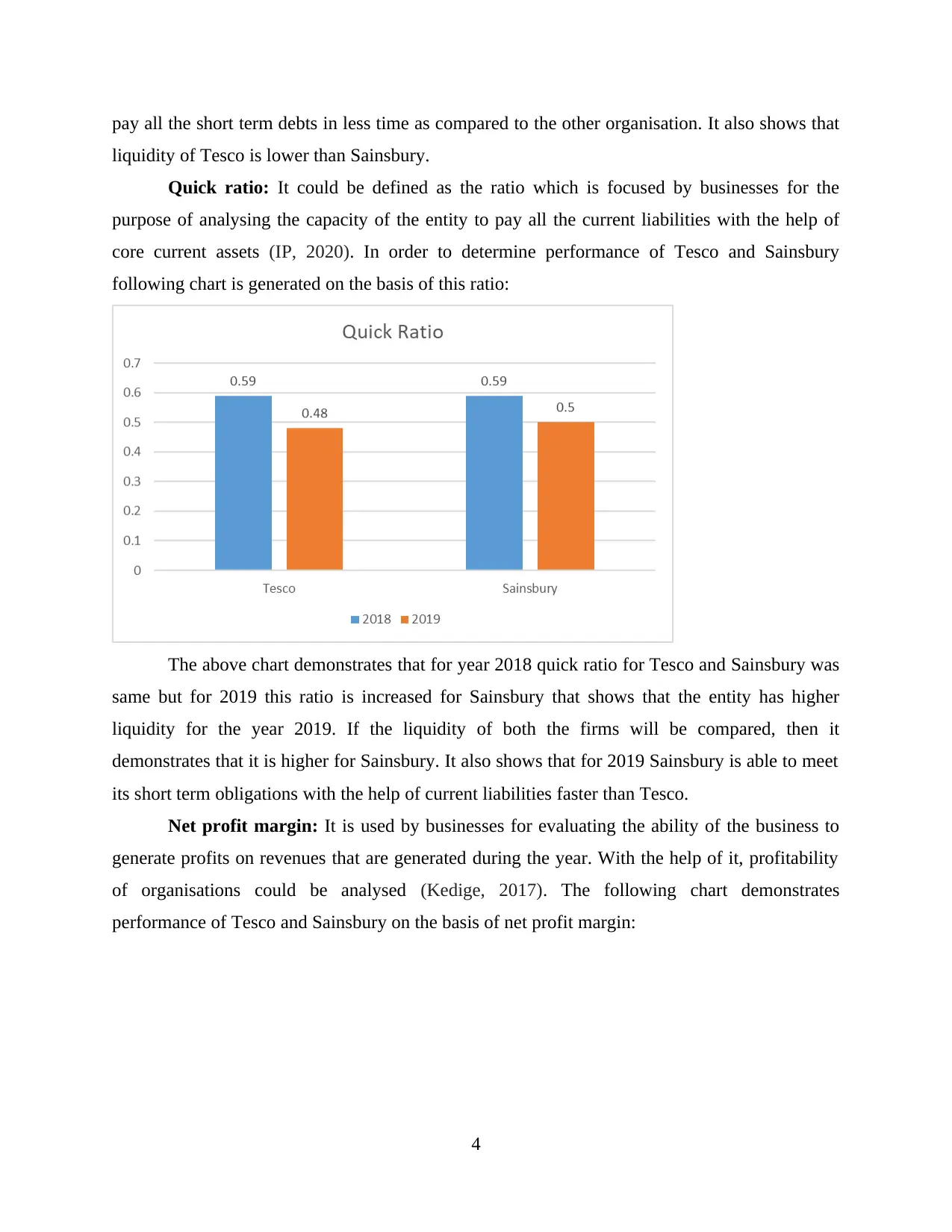
pay all the short term debts in less time as compared to the other organisation. It also shows that
liquidity of Tesco is lower than Sainsbury.
Quick ratio: It could be defined as the ratio which is focused by businesses for the
purpose of analysing the capacity of the entity to pay all the current liabilities with the help of
core current assets (IP, 2020). In order to determine performance of Tesco and Sainsbury
following chart is generated on the basis of this ratio:
The above chart demonstrates that for year 2018 quick ratio for Tesco and Sainsbury was
same but for 2019 this ratio is increased for Sainsbury that shows that the entity has higher
liquidity for the year 2019. If the liquidity of both the firms will be compared, then it
demonstrates that it is higher for Sainsbury. It also shows that for 2019 Sainsbury is able to meet
its short term obligations with the help of current liabilities faster than Tesco.
Net profit margin: It is used by businesses for evaluating the ability of the business to
generate profits on revenues that are generated during the year. With the help of it, profitability
of organisations could be analysed (Kedige, 2017). The following chart demonstrates
performance of Tesco and Sainsbury on the basis of net profit margin:
4
liquidity of Tesco is lower than Sainsbury.
Quick ratio: It could be defined as the ratio which is focused by businesses for the
purpose of analysing the capacity of the entity to pay all the current liabilities with the help of
core current assets (IP, 2020). In order to determine performance of Tesco and Sainsbury
following chart is generated on the basis of this ratio:
The above chart demonstrates that for year 2018 quick ratio for Tesco and Sainsbury was
same but for 2019 this ratio is increased for Sainsbury that shows that the entity has higher
liquidity for the year 2019. If the liquidity of both the firms will be compared, then it
demonstrates that it is higher for Sainsbury. It also shows that for 2019 Sainsbury is able to meet
its short term obligations with the help of current liabilities faster than Tesco.
Net profit margin: It is used by businesses for evaluating the ability of the business to
generate profits on revenues that are generated during the year. With the help of it, profitability
of organisations could be analysed (Kedige, 2017). The following chart demonstrates
performance of Tesco and Sainsbury on the basis of net profit margin:
4
⊘ This is a preview!⊘
Do you want full access?
Subscribe today to unlock all pages.

Trusted by 1+ million students worldwide
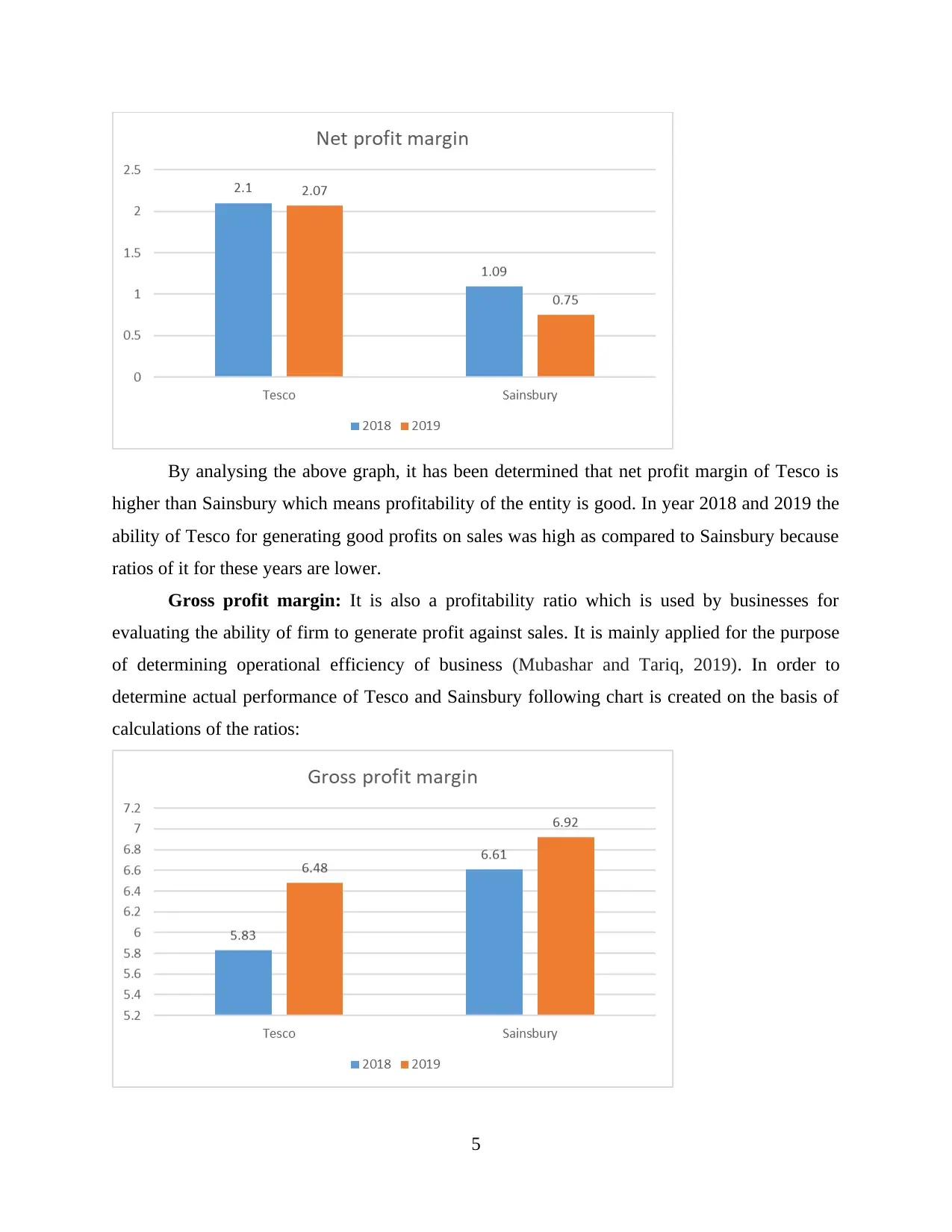
By analysing the above graph, it has been determined that net profit margin of Tesco is
higher than Sainsbury which means profitability of the entity is good. In year 2018 and 2019 the
ability of Tesco for generating good profits on sales was high as compared to Sainsbury because
ratios of it for these years are lower.
Gross profit margin: It is also a profitability ratio which is used by businesses for
evaluating the ability of firm to generate profit against sales. It is mainly applied for the purpose
of determining operational efficiency of business (Mubashar and Tariq, 2019). In order to
determine actual performance of Tesco and Sainsbury following chart is created on the basis of
calculations of the ratios:
5
higher than Sainsbury which means profitability of the entity is good. In year 2018 and 2019 the
ability of Tesco for generating good profits on sales was high as compared to Sainsbury because
ratios of it for these years are lower.
Gross profit margin: It is also a profitability ratio which is used by businesses for
evaluating the ability of firm to generate profit against sales. It is mainly applied for the purpose
of determining operational efficiency of business (Mubashar and Tariq, 2019). In order to
determine actual performance of Tesco and Sainsbury following chart is created on the basis of
calculations of the ratios:
5
Paraphrase This Document
Need a fresh take? Get an instant paraphrase of this document with our AI Paraphraser
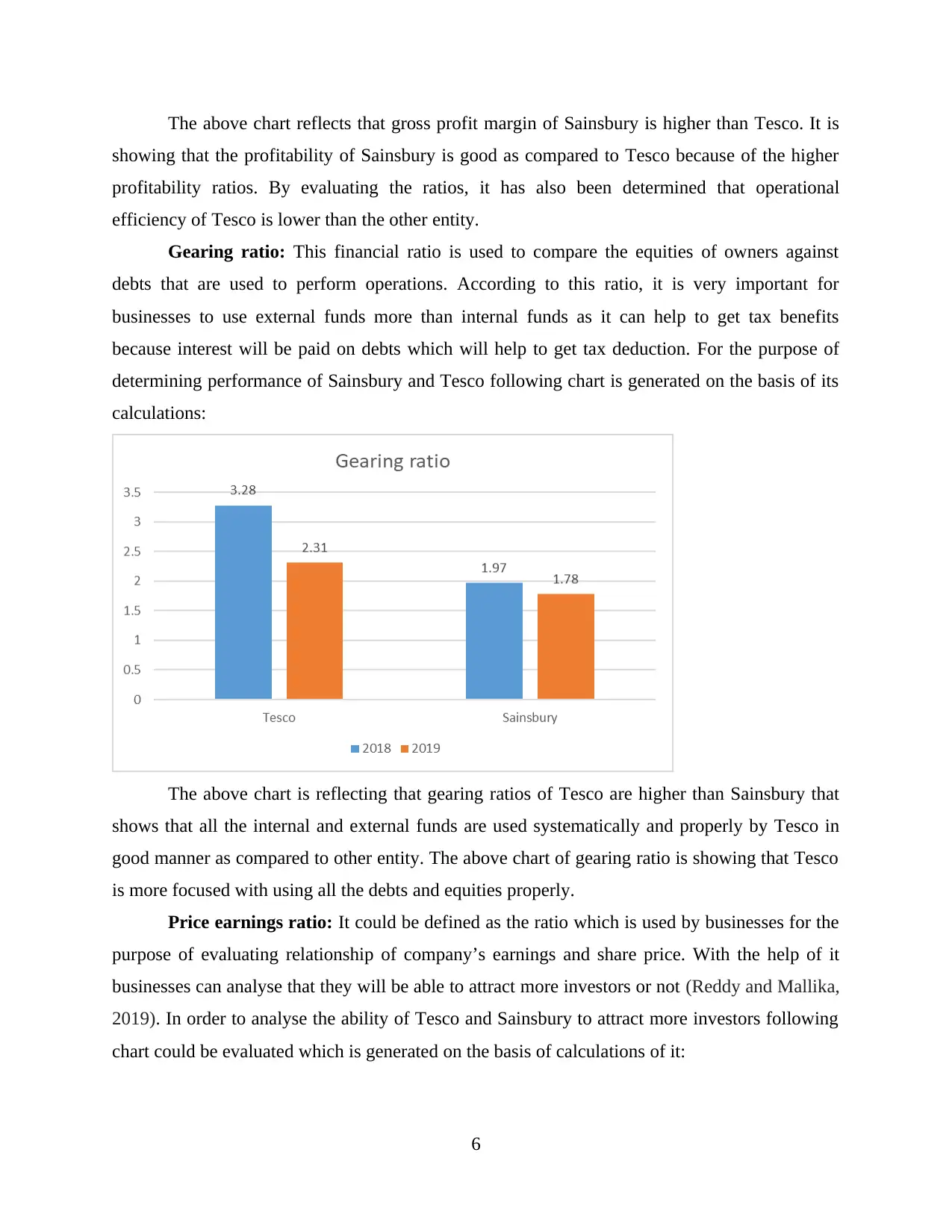
The above chart reflects that gross profit margin of Sainsbury is higher than Tesco. It is
showing that the profitability of Sainsbury is good as compared to Tesco because of the higher
profitability ratios. By evaluating the ratios, it has also been determined that operational
efficiency of Tesco is lower than the other entity.
Gearing ratio: This financial ratio is used to compare the equities of owners against
debts that are used to perform operations. According to this ratio, it is very important for
businesses to use external funds more than internal funds as it can help to get tax benefits
because interest will be paid on debts which will help to get tax deduction. For the purpose of
determining performance of Sainsbury and Tesco following chart is generated on the basis of its
calculations:
The above chart is reflecting that gearing ratios of Tesco are higher than Sainsbury that
shows that all the internal and external funds are used systematically and properly by Tesco in
good manner as compared to other entity. The above chart of gearing ratio is showing that Tesco
is more focused with using all the debts and equities properly.
Price earnings ratio: It could be defined as the ratio which is used by businesses for the
purpose of evaluating relationship of company’s earnings and share price. With the help of it
businesses can analyse that they will be able to attract more investors or not (Reddy and Mallika,
2019). In order to analyse the ability of Tesco and Sainsbury to attract more investors following
chart could be evaluated which is generated on the basis of calculations of it:
6
showing that the profitability of Sainsbury is good as compared to Tesco because of the higher
profitability ratios. By evaluating the ratios, it has also been determined that operational
efficiency of Tesco is lower than the other entity.
Gearing ratio: This financial ratio is used to compare the equities of owners against
debts that are used to perform operations. According to this ratio, it is very important for
businesses to use external funds more than internal funds as it can help to get tax benefits
because interest will be paid on debts which will help to get tax deduction. For the purpose of
determining performance of Sainsbury and Tesco following chart is generated on the basis of its
calculations:
The above chart is reflecting that gearing ratios of Tesco are higher than Sainsbury that
shows that all the internal and external funds are used systematically and properly by Tesco in
good manner as compared to other entity. The above chart of gearing ratio is showing that Tesco
is more focused with using all the debts and equities properly.
Price earnings ratio: It could be defined as the ratio which is used by businesses for the
purpose of evaluating relationship of company’s earnings and share price. With the help of it
businesses can analyse that they will be able to attract more investors or not (Reddy and Mallika,
2019). In order to analyse the ability of Tesco and Sainsbury to attract more investors following
chart could be evaluated which is generated on the basis of calculations of it:
6

From the above chart it has been analysed that price earnings ratio of Sainsbury is very
high as compared to Tesco which shows that relative value of shares of Sainsbury is very high.
Lower PE ratio is good for Tesco because it shows that investors get more earnings for their
investments and it will attract large number of investors.
Earnings per share: It is the part of profits of the organisation which is allocated to all
the outstanding shares of the organisation. With the help of it, total earnings that are generated by
the entity on each share could be evaluated (Sergi and Sari, 2020). Following chart shows
changes in EPS of Tesco and Sainsbury for year 2018 and 2019:
7
high as compared to Tesco which shows that relative value of shares of Sainsbury is very high.
Lower PE ratio is good for Tesco because it shows that investors get more earnings for their
investments and it will attract large number of investors.
Earnings per share: It is the part of profits of the organisation which is allocated to all
the outstanding shares of the organisation. With the help of it, total earnings that are generated by
the entity on each share could be evaluated (Sergi and Sari, 2020). Following chart shows
changes in EPS of Tesco and Sainsbury for year 2018 and 2019:
7
⊘ This is a preview!⊘
Do you want full access?
Subscribe today to unlock all pages.

Trusted by 1+ million students worldwide
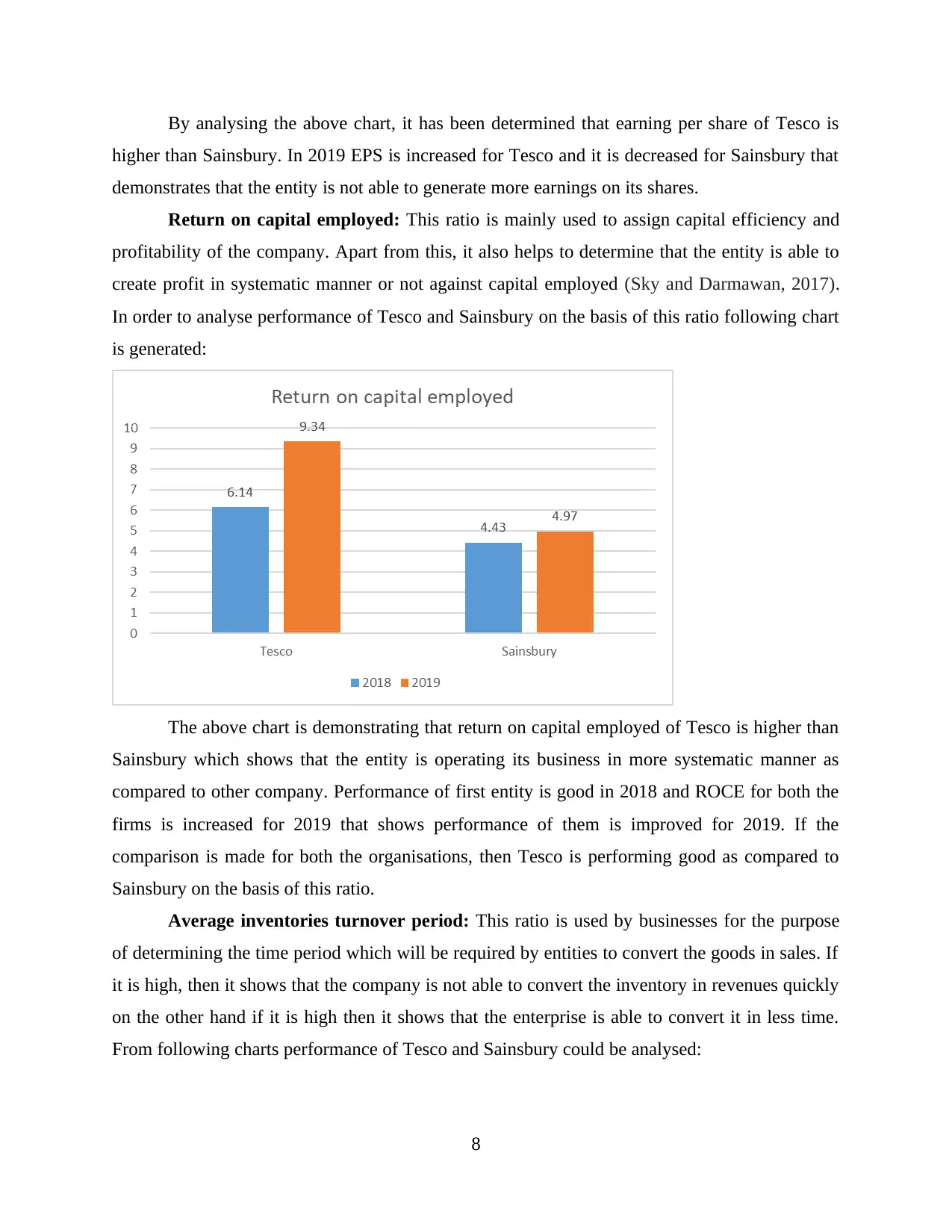
By analysing the above chart, it has been determined that earning per share of Tesco is
higher than Sainsbury. In 2019 EPS is increased for Tesco and it is decreased for Sainsbury that
demonstrates that the entity is not able to generate more earnings on its shares.
Return on capital employed: This ratio is mainly used to assign capital efficiency and
profitability of the company. Apart from this, it also helps to determine that the entity is able to
create profit in systematic manner or not against capital employed (Sky and Darmawan, 2017).
In order to analyse performance of Tesco and Sainsbury on the basis of this ratio following chart
is generated:
The above chart is demonstrating that return on capital employed of Tesco is higher than
Sainsbury which shows that the entity is operating its business in more systematic manner as
compared to other company. Performance of first entity is good in 2018 and ROCE for both the
firms is increased for 2019 that shows performance of them is improved for 2019. If the
comparison is made for both the organisations, then Tesco is performing good as compared to
Sainsbury on the basis of this ratio.
Average inventories turnover period: This ratio is used by businesses for the purpose
of determining the time period which will be required by entities to convert the goods in sales. If
it is high, then it shows that the company is not able to convert the inventory in revenues quickly
on the other hand if it is high then it shows that the enterprise is able to convert it in less time.
From following charts performance of Tesco and Sainsbury could be analysed:
8
higher than Sainsbury. In 2019 EPS is increased for Tesco and it is decreased for Sainsbury that
demonstrates that the entity is not able to generate more earnings on its shares.
Return on capital employed: This ratio is mainly used to assign capital efficiency and
profitability of the company. Apart from this, it also helps to determine that the entity is able to
create profit in systematic manner or not against capital employed (Sky and Darmawan, 2017).
In order to analyse performance of Tesco and Sainsbury on the basis of this ratio following chart
is generated:
The above chart is demonstrating that return on capital employed of Tesco is higher than
Sainsbury which shows that the entity is operating its business in more systematic manner as
compared to other company. Performance of first entity is good in 2018 and ROCE for both the
firms is increased for 2019 that shows performance of them is improved for 2019. If the
comparison is made for both the organisations, then Tesco is performing good as compared to
Sainsbury on the basis of this ratio.
Average inventories turnover period: This ratio is used by businesses for the purpose
of determining the time period which will be required by entities to convert the goods in sales. If
it is high, then it shows that the company is not able to convert the inventory in revenues quickly
on the other hand if it is high then it shows that the enterprise is able to convert it in less time.
From following charts performance of Tesco and Sainsbury could be analysed:
8
Paraphrase This Document
Need a fresh take? Get an instant paraphrase of this document with our AI Paraphraser

By analysing the above chart, it has been evaluated that average turnover ratio of Tesco is
higher than Sainsbury which shows that Tesco is taking more time as compared to another
company to convert stock in sales. If the performance on the basis of this ratio is evaluated
separately for both the firms, then it shows that Sainsbury is managing it properly as it is
decreased for the company for year 2019.
Dividend pay-out ratio: It is used in businesses for the purpose of analysing relationship
between the dividend and net income of the company so that the engagement level of
shareholders could be increased. On the basis of calculation of it following chart is generated for
Tesco and Sainsbury:
9
higher than Sainsbury which shows that Tesco is taking more time as compared to another
company to convert stock in sales. If the performance on the basis of this ratio is evaluated
separately for both the firms, then it shows that Sainsbury is managing it properly as it is
decreased for the company for year 2019.
Dividend pay-out ratio: It is used in businesses for the purpose of analysing relationship
between the dividend and net income of the company so that the engagement level of
shareholders could be increased. On the basis of calculation of it following chart is generated for
Tesco and Sainsbury:
9
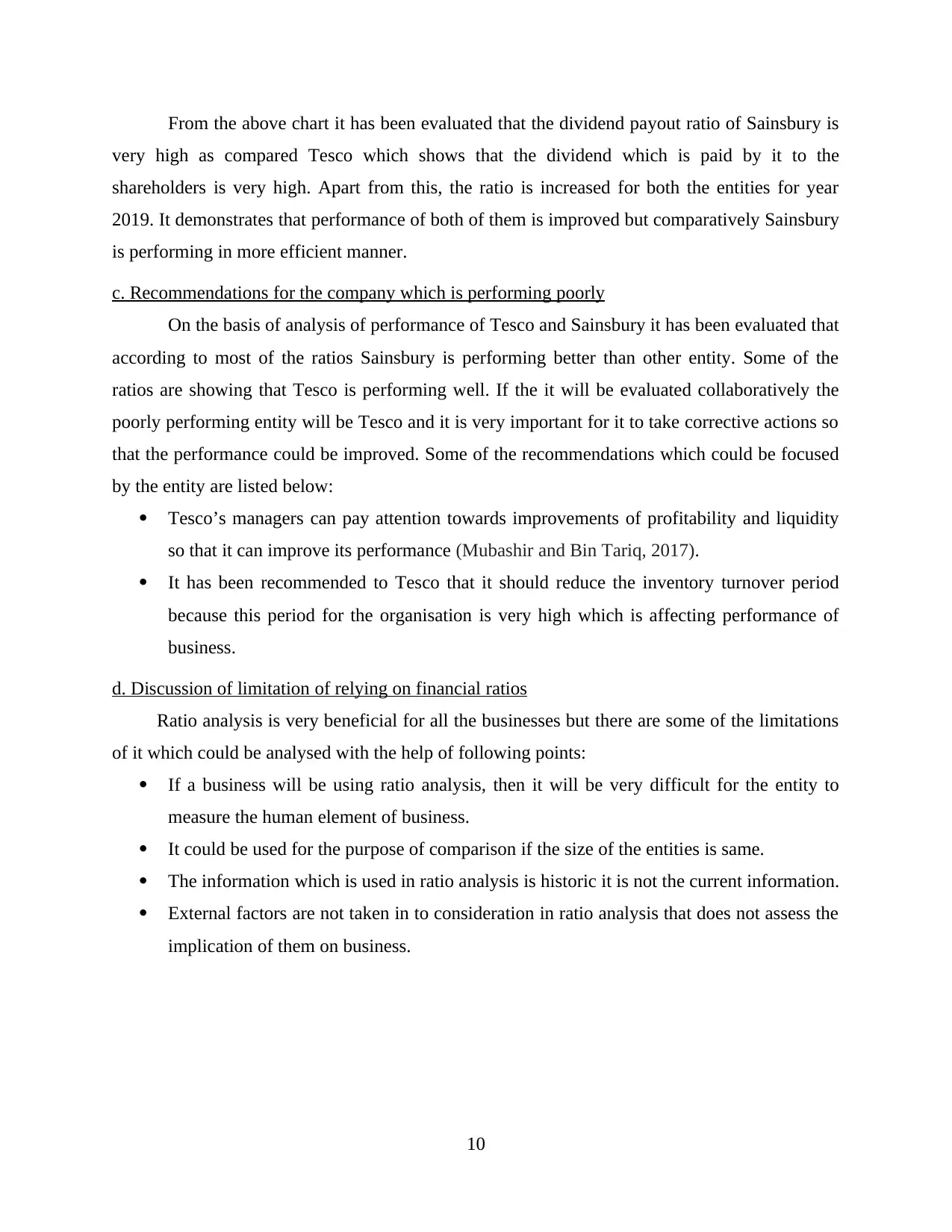
From the above chart it has been evaluated that the dividend payout ratio of Sainsbury is
very high as compared Tesco which shows that the dividend which is paid by it to the
shareholders is very high. Apart from this, the ratio is increased for both the entities for year
2019. It demonstrates that performance of both of them is improved but comparatively Sainsbury
is performing in more efficient manner.
c. Recommendations for the company which is performing poorly
On the basis of analysis of performance of Tesco and Sainsbury it has been evaluated that
according to most of the ratios Sainsbury is performing better than other entity. Some of the
ratios are showing that Tesco is performing well. If the it will be evaluated collaboratively the
poorly performing entity will be Tesco and it is very important for it to take corrective actions so
that the performance could be improved. Some of the recommendations which could be focused
by the entity are listed below:
Tesco’s managers can pay attention towards improvements of profitability and liquidity
so that it can improve its performance (Mubashir and Bin Tariq, 2017).
It has been recommended to Tesco that it should reduce the inventory turnover period
because this period for the organisation is very high which is affecting performance of
business.
d. Discussion of limitation of relying on financial ratios
Ratio analysis is very beneficial for all the businesses but there are some of the limitations
of it which could be analysed with the help of following points:
If a business will be using ratio analysis, then it will be very difficult for the entity to
measure the human element of business.
It could be used for the purpose of comparison if the size of the entities is same.
The information which is used in ratio analysis is historic it is not the current information.
External factors are not taken in to consideration in ratio analysis that does not assess the
implication of them on business.
10
very high as compared Tesco which shows that the dividend which is paid by it to the
shareholders is very high. Apart from this, the ratio is increased for both the entities for year
2019. It demonstrates that performance of both of them is improved but comparatively Sainsbury
is performing in more efficient manner.
c. Recommendations for the company which is performing poorly
On the basis of analysis of performance of Tesco and Sainsbury it has been evaluated that
according to most of the ratios Sainsbury is performing better than other entity. Some of the
ratios are showing that Tesco is performing well. If the it will be evaluated collaboratively the
poorly performing entity will be Tesco and it is very important for it to take corrective actions so
that the performance could be improved. Some of the recommendations which could be focused
by the entity are listed below:
Tesco’s managers can pay attention towards improvements of profitability and liquidity
so that it can improve its performance (Mubashir and Bin Tariq, 2017).
It has been recommended to Tesco that it should reduce the inventory turnover period
because this period for the organisation is very high which is affecting performance of
business.
d. Discussion of limitation of relying on financial ratios
Ratio analysis is very beneficial for all the businesses but there are some of the limitations
of it which could be analysed with the help of following points:
If a business will be using ratio analysis, then it will be very difficult for the entity to
measure the human element of business.
It could be used for the purpose of comparison if the size of the entities is same.
The information which is used in ratio analysis is historic it is not the current information.
External factors are not taken in to consideration in ratio analysis that does not assess the
implication of them on business.
10
⊘ This is a preview!⊘
Do you want full access?
Subscribe today to unlock all pages.

Trusted by 1+ million students worldwide
1 out of 17
Related Documents
Your All-in-One AI-Powered Toolkit for Academic Success.
+13062052269
info@desklib.com
Available 24*7 on WhatsApp / Email
![[object Object]](/_next/static/media/star-bottom.7253800d.svg)
Unlock your academic potential
Copyright © 2020–2025 A2Z Services. All Rights Reserved. Developed and managed by ZUCOL.





